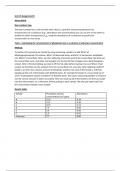Unit 15 Assignment B
Aimee Baish
Beer-Lambert Law
The Beer-Lambert law is the law that when there is a positive relationship between two
characteristics of a substance (e.g., absorbance and concentration) you can use one or the other to
predict the other characteristic (e.g., using the absorbance of a substance to predict the
concentration or vice versa).
Task 1- Calculating the concentration of phosphate ions in a solution of unknown concentration
Method:
To perform this practical we started by using measuring cylinders to add 30cm³ of
dihydrogenphosphate (V) solution, 60cm³ of deionised water and 6cm³ of ammonium molybdate
into 250cm³ conical flask. After, we then added 1g of ascorbic acid to the conical flask. We then put
the conical flask onto a hot plate and brought it to the boil (it then changes into a dark blue/green
colour). After it finished boiling, we took it off the hot plate before leaving it to cool. When it had
cooled, we had then put the solution from the conical flask into a burette. After labelling 6 100cm³
beakers, we then put a known amount of phosphate solution into each of the beakers, and then,
topping up the rest of the beaker with distilled water, for example for beaker A, it was made up of
15cm³ of phosphate solution and 85cm³ of distilled water. We used a measuring cylinder to measure
out the correct amount of water accurately. After we made up all of the beakers, we then put water
into the colourimeter, as a reference, before putting in each sample. We also put water back into
the colourimeter between each sample.
Results table:
Sample Phosphate solution Absorbance
concentration (cm³ ppm)
A 15.0 0.19
B 12.5 0.16
C 10.0 0.13
D 7.5 0.09
E 5.0 0.06
F 2.5 0.02
Unknown ??? 0.06
, Graph
Concentration of unknown sample
From the graph above, and the use of the Beer-Lambert law, we can see that the concentration of
the unknown solution is 5 cm³ ppm. This means that, due to the positive relationship between the
absorbance and the concentration of phosphate ions present in the substance, we can determine
the concentration of the unknown sample using the line of best fit.
This is not the most accurate way of finding out the concentration of a substance, the most accurate
way would be to find out other characteristics of the substance and then use those characteristics in
a calculation (e.g., the moles, mass, and concentration), this is because the line of best fit may be
drawn at a different angle depending on who draws it, so, the number that you may match up to
could be different depending on how you drew your graph.
However, we did not have that information and the Beer-Lambert law is very accurate, which means
that although there are more accurate ways to determine the concentration, this was the best way
for our experiment, and this is still accurate as it uses other results to determine this and as we used
graduated pipettes and wiped the cuvettes, these readings were accurate. This means that the graph
was drawn with accuracy as the line of best fit went through all of the points. So, we can see that the
graph has determined the concentration of phosphate ions present in the unknown sample
accurately.




